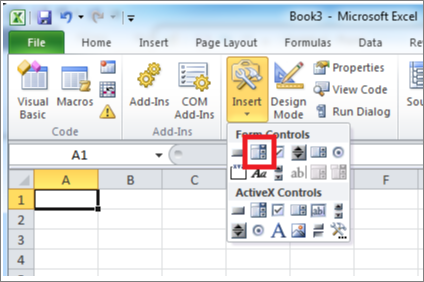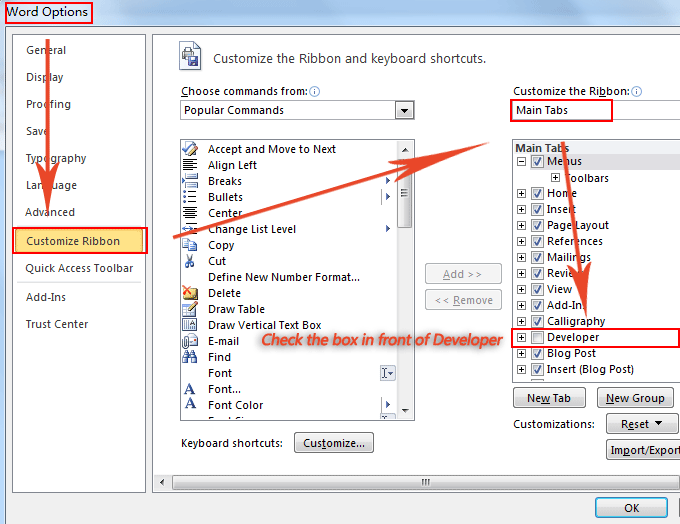To add/enable developer tab in excel 2007, 2010, 2013, 2016 & excel 2011 For Mac. Just Follow these simple steps to insert the developer tab in excel ribbon. How your phone number or email address is used. Microsoft will use your phone number or email address only for this one-time transaction. Standard SMS rates may apply. Excel learns your patterns, organizing your data to save you time. Easily create spreadsheets from templates or on your own. On the File menu, click 'Close and Return to Microsoft Excel.' Click the Sheet1 tab. On the Tools menu, point to Macro, and then click Macros. Click CalendarMaker, and then click Run to create the calendar. Microsoft Excel 2007 or later. Create a new workbook. On the Developer ribbon, Click Visual Basic. On the Insert menu, click Module.
-->
Note
Office 365 ProPlus is being renamed to Microsoft 365 Apps for enterprise. For more information about this change, read this blog post.
Summary
This article contains a sample Microsoft Visual Basic for Applications macro (sub-procedure) that prompts you for the month and year and creates a monthly calendar by using a worksheet.
Resolution
Note
Microsoft provides programming examples for illustration only, without warranty either expressed or implied. This includes, but is not limited to, the implied warranties of merchantability or fitness for a particular purpose. This article assumes that you are familiar with the programming language that is being demonstrated and with the tools that are used to create and to debug procedures. Microsoft support engineers can help explain the functionality of a particular procedure, but they will not modify these examples to provide added functionality or construct procedures to meet your specific requirements.
To create the calendar, follow these steps.
Microsoft Excel 2003
- Create a workbook.
- On the Tools menu, point to Macro, and then select Visual Basic Editor.
- On the Insert menu, select Module.
- Paste the Visual Basic for Applications script from the 'Sample Visual Basic procedure' section into the module sheet.
- On the File menu, select Close and Return to Microsoft Excel.
- Select the Sheet1 tab.
- On the Tools menu, point to Macro, and then select Macros.
- Select CalendarMaker, and then select Run to create the calendar.
Microsoft Excel 2007 or later
- Create a workbook.
- On the Developer ribbon, select Visual Basic.
- On the *Insert menu, select Module.
- Paste the Visual Basic for Applications script from the 'Sample Visual Basic procedure' section into the module sheet.
- On the File menu, select Close and Return to Microsoft Excel.
- Select the Sheet1 tab.
- On the *Developer ribbon, click Macros.
- Select CalendarMaker, and then select *Run to create the calendar.
Note
If the Developer ribbon is not visible, open Excel Options to enable it. In Excel 2007, the option is available on the Popular menu. In Excel 2010, the option is available on the Customize Ribbon menu.
Sample Visual Basic procedure
You can add other code to customize the calendar to meet your needs. Insert extra rows for entry on the screen for each day or resize the screen to see the whole calendar based on screen size and resolution.
This Excel tutorial explains how to create a button in Excel 2007 (with screenshots and step-by-step instructions).
Question: I knew how to create a button in Microsoft Excel 2003, but how do I create a button in Excel 2007?
Answer: To create a button in Excel 2007, click on the Microsoft Office button in the top left of the Excel window and then click on the Excel Options button.

Note
Office 365 ProPlus is being renamed to Microsoft 365 Apps for enterprise. For more information about this change, read this blog post.
Summary
This article contains a sample Microsoft Visual Basic for Applications macro (sub-procedure) that prompts you for the month and year and creates a monthly calendar by using a worksheet.
Resolution
Note
Microsoft provides programming examples for illustration only, without warranty either expressed or implied. This includes, but is not limited to, the implied warranties of merchantability or fitness for a particular purpose. This article assumes that you are familiar with the programming language that is being demonstrated and with the tools that are used to create and to debug procedures. Microsoft support engineers can help explain the functionality of a particular procedure, but they will not modify these examples to provide added functionality or construct procedures to meet your specific requirements.
To create the calendar, follow these steps.
Microsoft Excel 2003
- Create a workbook.
- On the Tools menu, point to Macro, and then select Visual Basic Editor.
- On the Insert menu, select Module.
- Paste the Visual Basic for Applications script from the 'Sample Visual Basic procedure' section into the module sheet.
- On the File menu, select Close and Return to Microsoft Excel.
- Select the Sheet1 tab.
- On the Tools menu, point to Macro, and then select Macros.
- Select CalendarMaker, and then select Run to create the calendar.
Microsoft Excel 2007 or later
- Create a workbook.
- On the Developer ribbon, select Visual Basic.
- On the *Insert menu, select Module.
- Paste the Visual Basic for Applications script from the 'Sample Visual Basic procedure' section into the module sheet.
- On the File menu, select Close and Return to Microsoft Excel.
- Select the Sheet1 tab.
- On the *Developer ribbon, click Macros.
- Select CalendarMaker, and then select *Run to create the calendar.
Note
If the Developer ribbon is not visible, open Excel Options to enable it. In Excel 2007, the option is available on the Popular menu. In Excel 2010, the option is available on the Customize Ribbon menu.
Sample Visual Basic procedure
You can add other code to customize the calendar to meet your needs. Insert extra rows for entry on the screen for each day or resize the screen to see the whole calendar based on screen size and resolution.
This Excel tutorial explains how to create a button in Excel 2007 (with screenshots and step-by-step instructions).
Question: I knew how to create a button in Microsoft Excel 2003, but how do I create a button in Excel 2007?
Answer: To create a button in Excel 2007, click on the Microsoft Office button in the top left of the Excel window and then click on the Excel Options button.
When the Excel Options window appears, click on the Popular option on the left. Select the option called 'Show Developer tab in the Ribbon'. Then click on the OK button.
Select the Developer tab from the toolbar at the top of the screen. In the Controls group, click on the Insert button and a menu will popup. Click on the button icon under the Form Controls section (see picture below) in the popup menu.
Tab Developer In Excel 2007
Position your cursor in the spreadsheet and hold down the left mouse button and drag until your button is the correct size. Then let go of the left mouse button. A button will appear on your spreadsheet as follows:
Developer In Excel 2010
Immediately, an Assign Macro window will appear. Select the macro that you wish to assign to this button and click on the OK button.
Developer Option In Excel 2016
If you wish to change the text that appears on the button, highlight the button text and type the text that you wish to appear in the button object.
